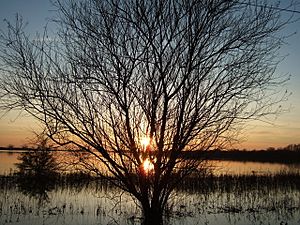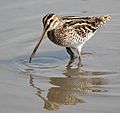Ouse Washes facts for kids
| Site of Special Scientific Interest | |
 |
|
| Area of Search | Cambridgeshire Norfolk |
|---|---|
| Interest | Biological |
| Area | 2,513.6 hectares |
| Notification | 1984 |
| Location map | Magic Map |
|
Designations
|
|
| Official name: Ouse Washes | |
| Designated: | 5 January 1976 |
|---|---|
| Reference #: | 77 |
The Ouse Washes is a very special natural area in England. It stretches for about 2,513 hectares (that's like 6,200 football fields!) from St Ives in Cambridgeshire to Downham Market in Norfolk. This area is known as a Site of Special Scientific Interest, which means it's protected because of its amazing wildlife and natural features.
The Ouse Washes is also a Ramsar site, which means it's an internationally important wetland. It's a key place for birds under the European Union's Birds Directive and a Special Area of Conservation. Different groups help look after this important place. The Wildlife Trust for Bedfordshire, Cambridgeshire and Northamptonshire manages an area between March and Ely. The Royal Society for the Protection of Birds (RSPB) looks after another part near Chatteris. The Wildfowl & Wetlands Trust (WWT) also manages an area near Welney.
Contents
Wildlife and Nature
The Ouse Washes is located between two rivers: the Old Bedford River and the New Bedford River. This area is designed to hold floodwater, so it often gets covered in water during winter. This makes it a perfect home for many birds.
It's super important for birds that spend the winter here or come to breed. You can see lots of different wildfowl and waders. Some of the birds you might spot include teal, pintail, wigeon, shoveler, pochard, and Bewick's swans. Besides birds, the Ouse Washes also has a rich variety of water animals and plants. There are also areas of natural grassland that haven't been changed by farming.
History of the Washes
The Ouse Washes were created a long time ago to help drain the land. In 1630, King Charles I gave permission for a big drainage project. The 4th Earl of Bedford started building the Old Bedford River. This river was built between Earith and Downham Market.
Later, in 1649, a Dutch engineer named Cornelius Vermuyden helped finish the project. He built the New Bedford River right next to the old one. The land between these two rivers is about 20 miles (32 km) long and nearly a mile wide. This area acts as a "washland." This means it's a floodplain that fills with water in the winter. Sometimes, it even floods in the summer. When the Washes are flooded, local people have to take a detour of about 30 miles (48 km) to get around!
RSPB Ouse Washes Nature Reserve
The Royal Society for the Protection of Birds (RSPB) manages a nature reserve here called RSPB Ouse Washes. It's located at Welches Dam. You can find it by following signs from Manea village. Manea is about 6 miles (10 km) east of Chatteris on the A142/A141 roads, between Ely and March.
The visitor centre at the reserve is open every day from 9 am to 5 pm. It's only closed on Christmas Day and Boxing Day. It's a great place to learn about the birds and nature of the Ouse Washes.
WWT Welney Wetland Centre
The WWT Welney Wetland Centre is another amazing place to visit. It's one of nine wildfowl and wetland reserves managed by the Wildfowl & Wetlands Trust. This reserve is in Welney in Norfolk. It's about 12 miles (19 km) north of Ely, 26 miles (42 km) north of Cambridge, and 33 miles (53 km) east of Peterborough.
The visitor centre at Welney is built to be eco-friendly. It has displays about the history and nature of The Fens area and the people who live there. There's also an art gallery, a gift shop, and a café. You can take part in nature programs, try pond dipping, explore trails, and watch birds from special hides. In 2018, nearly 30,000 people visited the centre!
Ouse Washes Landscape Partnership
The Ouse Washes Landscape Partnership scheme (OWLP) was a special project that ran from 2014 to 2017. It was supported by the Heritage Lottery Fund. The main goal of this project was to promote the area around the Ouse Washes. This area is right in the heart of the Cambridgeshire and Norfolk Fens. The partnership also worked to get local communities involved in learning about the area's rich history and nature.
Images for kids
-
Peter Scott in 1954
-
An RSPB hide overlooking the Old Bedford River
-
Tansy beetle on tansy flower heads






